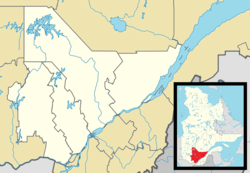L'Ancienne-Lorette | |
|---|---|
 | |
 Location within Quebec TE. | |
| Coordinates: 46°47′55″N 71°21′45″W / 46.79861°N 71.36250°W[1] | |
| Country | Canada |
| Province | Quebec |
| Region | Capitale-Nationale |
| RCM | None |
| Agglomeration | Quebec City |
| Settled | 1674 |
| Constituted | January 1, 2006 |
| Government | |
| • Mayor | Gaétan Pageau |
| • Federal riding | Louis-Saint-Laurent |
| • Prov. riding | La Peltrie |
| Area | |
| • Total | 7.70 km2 (2.97 sq mi) |
| • Land | 7.72 km2 (2.98 sq mi) |
| Population (2021)[3] | |
| • Total | 16,970 |
| • Density | 2,197/km2 (5,690/sq mi) |
| • Pop 2016-2021 | |
| • Dwellings | 7,516 |
| Time zone | UTC−5 (EST) |
| • Summer (DST) | UTC−4 (EDT) |
| Postal code(s) | |
| Area code(s) | 418 and 581 |
| Highways | |
| Website | www |
L'Ancienne-Lorette is a city in central Quebec, Canada. It is a suburb of and an enclave within Quebec City. It was merged with Quebec City on January 1, 2002, as part of a 2000–2006 municipal reorganization in Quebec, but, after a 2004 referendum, it was reconstituted as a separate city on January 1, 2006.
Its history dates to 1674, when a group of Huron (Wyandot) fleeing war with the Iroquois settled there under the protection of the French. It was founded as a mission village by the Jesuits. The Wyandot left after a few decades, and French settlers took over the land.
History
The Jesuit missionary Pierre Chaumonot in 1674 founded a settlement here when he built a chapel for the Huron (Wyandot). Following his third and final trip to the shrine of Loreto in Italy, Chaumonot was cured of a terrible headache. In gratitude, he placed the colony under the patronage of Our Lady of the Annunciation, but it is still commonly called Lorette.[1]
In 1697, the Huron left the village in search of better land for hunting and fishing. Afterward the site became known in French as Vieille-Lorette ("Old Loreto") or Ancienne-Lorette ("Former Loreto"). A new location became known as Nouvelle-Lorette ("New Loreto") or Jeune-Lorette ("Young Loreto"). That site roughly corresponds to the Loretteville of today. A year later in 1698, the Parish of Notre-Dame-de-l'Annonciation was established.[1]
In 1948, the place was incorporated as the village municipality of Notre-Dame-de-Lorette. In 1967, it gained town status and took back its original name, L'Ancienne-Lorette, to distinguish itself from the Notre-Dame-de-Lorette Lac-Saint-Jean region.[1]
Until 1971, L'Ancienne-Lorette was the gateway to Quebec's International Airport. It used to be known as L'Ancienne-Lorette Airport. In 1971 the rural section of the town that included the airport was annexed by Sainte-Foy.
On January 1, 2002, L'Ancienne-Lorette was merged with Quebec City as part of a province-wide municipal reorganization and became part of the Laurentien borough of that city. After a 2004 referendum, it regained independent city status on January 1, 2006.
Demographics
In the 2021 Census of Population conducted by Statistics Canada, L'Ancienne-Lorette had a population of 16,970 living in 7,314 of its 7,516 total private dwellings, a change of 2.6% from its 2016 population of 16,543. With a land area of 7.72 km2 (2.98 sq mi), it had a population density of 2,198.2/km2 (5,693.3/sq mi) in 2021.[4]
According to the Canada 2021 Census:[5]
- Population: 16,970
- % Change (2016–2021): +2.6
- Private dwellings occupied by usual residents: 7,314 (total dwellings: 7,516)
- Area (km2): 7.72 km2
- Density (persons per km2): 2,197.0
- Mother tongue:
- English as first language: 1.1%
- French as first language: 94.2%
- English and French as first language: 0.8%
- Other as first language: 3.5%
Population trend:[6]
- Population in 2021: 16,970 (2006 to 2011 population change: 2.6%)
- Population in 2016: 16,543
- Population in 2011: 16,745
- Population in 2006: 16,516
- Population in 2001: 15,929
- Population in 1996: 15,895
- Population in 1991: 15,242
- Population in 1986: 13,747
- Population in 1981: 12,935
- Population in 1976: 11,694
- Population in 1971: 8,304
- Population in 1966: 5,691
- Population in 1961: 3,961
- Population in 1956: 3,464
- Population in 1951: 2,516
In 2021, L'Ancienne-Lorette was 94.3% White, 1.6% Black, 1.2% Latin American and 1% Arab.
Economy
Quebecair Express, prior to its disestablishment, had its headquarters in the city.[7]
Notable people
- Félix Auger-Aliassime (raised in L'Ancienne-Lorette), Canadian professional tennis player, junior singles and doubles US Open champion
- Patrice Bergeron, retired NHL hockey centre
- Mario Marois, NHL defenceman, principally for the Quebec Nordiques
- Antoine Plamondon (ca. 1804–1895), artist
- Évelyne Viens, Olympic gold medal-winning soccer player
See also
References
- ^ a b c d "L'Ancienne-Lorette (ville)" (in French). Commission de toponymie du Québec. Retrieved 2010-04-09.
- ^ a b Ministère des Affaires municipales, des Régions et de l'Occupation du territoire - Répertoire des municipalités: L'Ancienne-Lorette Archived 2013-07-13 at the Wayback Machine
- ^ a b Statistics Canada 2021 Census - L'Ancienne-Lorette census profile
- ^ "Population and dwelling counts: Canada, provinces and territories, and census subdivisions (municipalities), Quebec". Statistics Canada. February 9, 2022. Retrieved August 29, 2022.
- ^ Statistics Canada 2021 Census - L'Ancienne-Lorette community profile
- ^ Statistics Canada: 1996, 2001, 2006, 2011 census
- ^ "World Airline Directory." Flight International. 30 March - 5 April 2004. 58.
External links


